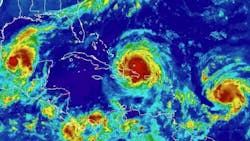Storm restoration is a dangerous process requiring the efforts of thousands of people to rebuild what the storm destroyed. It requires lots of boots on the ground and a huge support network feeding materials and equipment to the workers restoring power to the customers, but some innovative technologies are making the process faster. Utilities are spending millions of dollars to storm-harden their systems and deploying smart grid technologies to make those systems more resilient. Granted, there are limits to any technology when a monster storm hits, but our industry has been making progress in the battle.
Microgrids
In the aftermath of Superstorm Sandy there were many reports about microgrids providing power in areas of massive power outages. As a result, states like New York, Connecticut, and New Jersey deployed microgrid technology, and other areas are taking advantage of the technology. In Houston, the Texas Medical Center relied on backup energy and heat services provided for by Thermal Energy Corp. Also, a digitally networked natural gas-fueled microgrid system developed by ERock (Enchanted Rock) provided electricity to 22 convenience stores and gas stations. Natural gas generators are installed at sites, which when needed can be aggregated into virtual power plant microgrids and islanded from the grid. An Orlando home owner kept the lights on with Tesla’s Powerwall home battery system tied to rooftop solar panels while neighbors sat in the dark.
Another report told of a partnership between the Rocky Mountain Institute (RMI) and Virgin Group billionaire Richard Branson that started in 2014. The partnership built a microgrid on Necker Island several years ago. Necker Island is Branson’s private island in the British Virgin Islands. Their microgrid included wind, solar, and storage and offered a very resilient power supply. According to RMI, “The microgrid weathered Hurricane Irma quite well.” They also told about the islands of Turks and Caicos, which are also members of the RMI program. The report said a solar project there remained on line throughout the storm. These islands plus Montserrat and Anguilla are part of RMI’s planned project to install 95 MW of wind power by 2020.
Commercial Drones
In addition to microgrid technology, another digital innovation that is making an impact in storm restoration efforts are commercial drones. In the days following Hurricane Harvey, the FAA issued 137 airspace authorizations for drone related recovery missions. The FAA also issued 132 airspace authorizations for Hurricane Irma as restoration began in Florida. These figures illustrate how important this digital technology (payloads and guidance systems are digital) has become for hurricane responders. Commercial drones were used by local authorities, highway departments, telecom companies, railroads, and utilities (gas, water, & electricity). They were used for damage surveying, insurance claims, and most importantly power restoration. Utilities reported that drones gave them an edge when determining the damage to their system. It allowed personnel to survey circuits in flooded areas without being placed in harm’s way.
Smart Grid Schemes
Other digital technology making an impact on storm recovery are the smart grid schemes such as asset management systems, dynamic distribution monitoring systems, smart substations, and other intelligent systems. These digital asset management systems see the “whole” picture of what is taking place on the grid. With digital devices such as smart meters, smart switches, digital interrupters, and intelligent sectionalizers located on feeders, asset monitoring systems provide connectivity that make feeders into interactive networks. They can isolate faults, reclose when faults clear without damaging the fuse element, or reroute power around permanent faults. They do all of this automatically rather than waiting for a trouble crew to do the switching manually. When digital technology allows one part of the system to communicate to other parts, a lengthy outage can be reduced to a momentary flicker of the lights. With technological advancements like these the customer has been moved from the grid’s edge to being part of the interactive and automated digital center of the grid.
The 2017 hurricane season has been one of the most devastating seasons on record, but innovative digital technologies like these are helping to make a difference. Grid modernization has made storm response smarter. Our preparedness has improved restoration time by focusing resources where they can do the most good in getting the lights back on. Today’s systems are being improved with each lesson learned from monster storms and their impact to the grid. In 2005 Hurricane Wilma started the grid modernization mission with digital smart grid technology for storm resiliency. In 2012 Superstorm Sandy focused our attention on distributed energy resources more commonly referred to as microgrids. The jury is still out on Harvey, Irma, and Maria, but these storms provided a lot of data on the failures and successes of our smarter grid.
About the Author
Gene Wolf
Technical Editor
Gene Wolf has been designing and building substations and other high technology facilities for over 32 years. He received his BSEE from Wichita State University. He received his MSEE from New Mexico State University. He is a registered professional engineer in the states of California and New Mexico. He started his career as a substation engineer for Kansas Gas and Electric, retired as the Principal Engineer of Stations for Public Service Company of New Mexico recently, and founded Lone Wolf Engineering, LLC an engineering consulting company.
Gene is widely recognized as a technical leader in the electric power industry. Gene is a fellow of the IEEE. He is the former Chairman of the IEEE PES T&D Committee. He has held the position of the Chairman of the HVDC & FACTS Subcommittee and membership in many T&D working groups. Gene is also active in renewable energy. He sponsored the formation of the “Integration of Renewable Energy into the Transmission & Distribution Grids” subcommittee and the “Intelligent Grid Transmission and Distribution” subcommittee within the Transmission and Distribution committee.
